Many readers who are not habitual pedestrians, or who have not encountered a signalised slip lane in the wild yet, might be confused why advocacy groups are opposed to the signalisation of the slips at Webster Road. After all, won’t the signals make the crossing safer? Isn’t that why TMR is installing them? In this post, I’ll break down the issues around signalised slip lanes, and slip lanes more generally.
A slip lane is a short piece of road which allows nearside-turning traffic to bypass a signalised intersection. They are an exclusively North American and Australasian phenomenon, and are not used in the UK, Europe, or Japan.
The fact that some traffic at a busy intersection does not have to stop at the lights presents a problem for pedestrians trying to cross, of course. Therefore, in all Australian states and New Zealand, the road rules say that drivers must stop and give way to pedestrians crossing the slip lane. This road rule applies regardless of whether the slip lane is marked with a zebra crossing, with a signalised crossing, or with nothing at all.
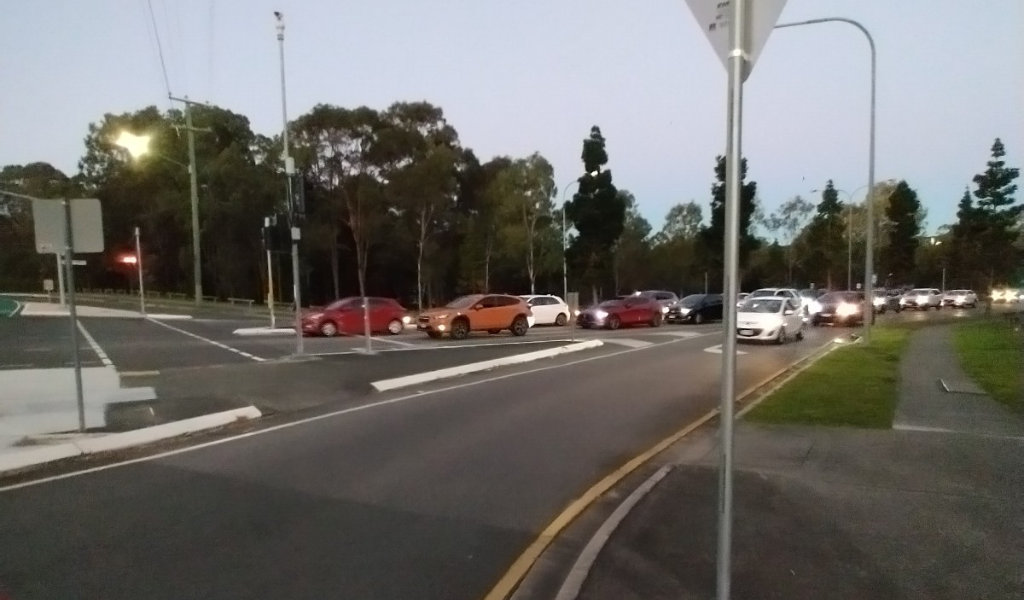
Of course, anyone who’s ever tried to cross the road at an unmarked slip lane knows that drivers do not stop and give way to pedestrians. In some cases, motorists might not know their road rules, but for the most part it’s because they are busy preparing to merge onto the road they’re turning into, and are looking for conflicting traffic coming from the other direction. There’s simply too much work to do in too short a time to be able to effectively watch and respond to pedestrians.
Zebra crossings are one tool that has been widely used to try and fix this fundamental flaw. A zebra crossing, with large reflective signs and bold pavement markings, draws motorists’ attention back to the possibility of pedestrians crossing the road.
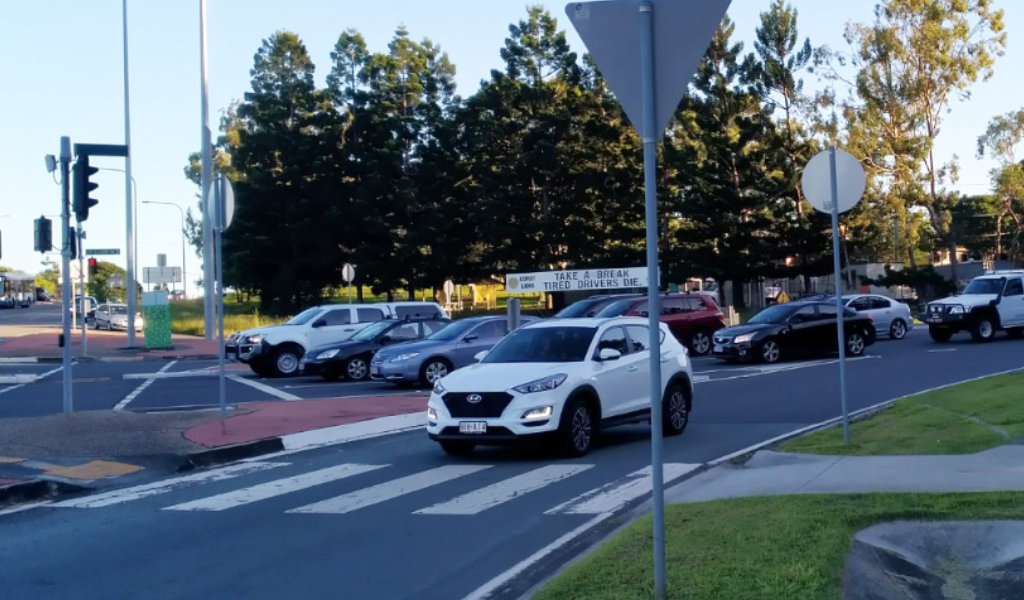
This has not been an unmitigated success. Motorists are still overworked and frequently miss seeing pedestrians, and pedestrians – emboldened by the presence of the crossing – are more likely to assert their right-of-way and step out in front of vehicles. Slip lanes with zebra crossings are dramatically over-represented in left-turn pedestrian collision statistics in Australia and New Zealand. And in recent years, improved safety rules for the construction of zebra crossings – including limits on allowable vehicle speeds and sight lines – have made marking zebra crossings on slip lanes impossible anyway.
That just leaves signalised slip lanes. A signalised slip lane has pedestrian activation buttons, red/green pedestrian lights, and signal lights for vehicles on the slip lane.
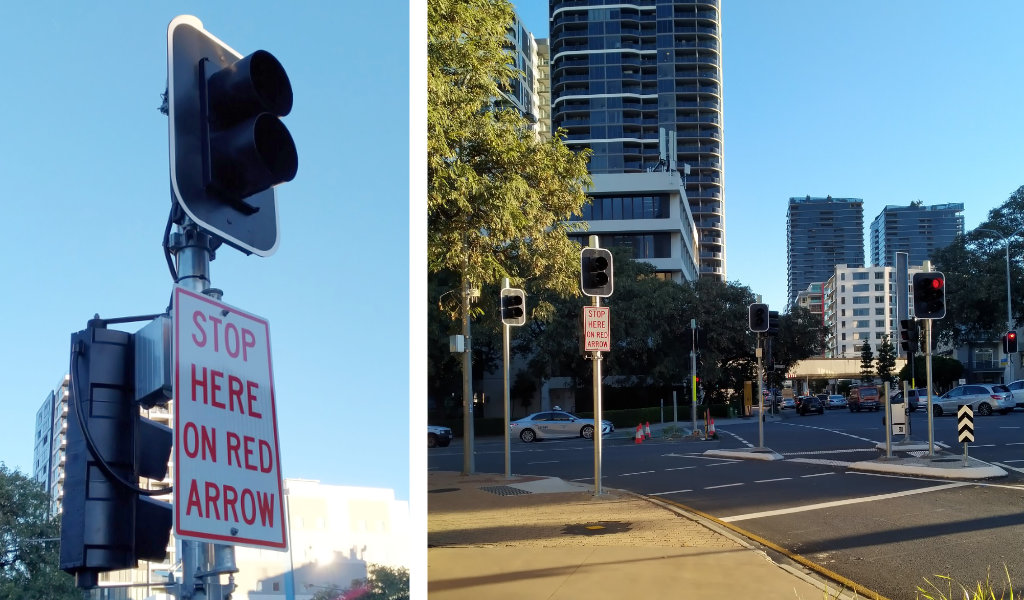
The default state is for the pedestrian light to be red, and the vehicle light to be off. Note that the vehicle signal heads do not have green lights. This is because motorists using the slip lane still need to give way, both to pedestrians crossing the slip lane and to traffic on the road they are turning into.
Signalisation is another attempt to fix the drivers-don’t-give-way problem: if they won’t stop for pedestrians, they can presumably be relied on to stop for a red traffic light. But it’s a very poor fix. Signalised slip lanes create a multitude of safety and compliance issues, including:
- Observing and obeying the signals adds to motorists’ workload, reducing their awareness of pedestrians even further. Most drivers will look first to the signal head, then turn to look for traffic, and not even think about people crossing the road.
- The road rules are contradictory. Drivers must give way, but the signals’ default state prevents pedestrians from legally crossing. This confuses and erodes everyone’s understanding of right-of-way at slip lanes.
- Pedestrians and cyclists won’t comply with the signals on such a short crossing anyway. With only a single lane to cross, most people won’t bother pressing the button and waiting for a walk signal, but will just look to see if anything’s coming then cross.
In short, nobody is going to follow the rules at a signalised slip lane – not pedestrians waiting for signals, and not motorists giving way to pedestrians – and that’s the hallmark of a truly unsafe design. The only reason we don’t know that signalised slip lanes are dangerous, the reason they’re not represented in the accident statistics, is that up until a few years ago no-one has been crazy enough to build them.
So why build them now, and why build them at Webster Road? As far as I can tell, the thought process goes like this:
- Unmarked slips are dangerous, and so not allowed.
- Slips with zebra crossings are dangerous, and so not allowed.
- We don’t know that signalised slips are dangerous, so they are allowed.
- Removing slip lanes is unacceptable to politicians.
Therefore, governments and councils signalise slip lanes, and will continue to do so until either 3) or 4) changes.
Hopefully it will be 4); either by convincing politicians that the community supports the removal of slip lanes, or by replacing elected recalcitrants at the earliest opportunity. If we’re waiting for safety standards to catch up with 3), then like all safety standards, they will be written in blood.
-David
PS:
To take photos of signalised slip lanes for this post, I went to South Brisbane this afternoon. The signalised slips behind the State Library were built last year as “compensation” for closing Victoria Bridge, because apparently we can’t have one step forward without two steps back.
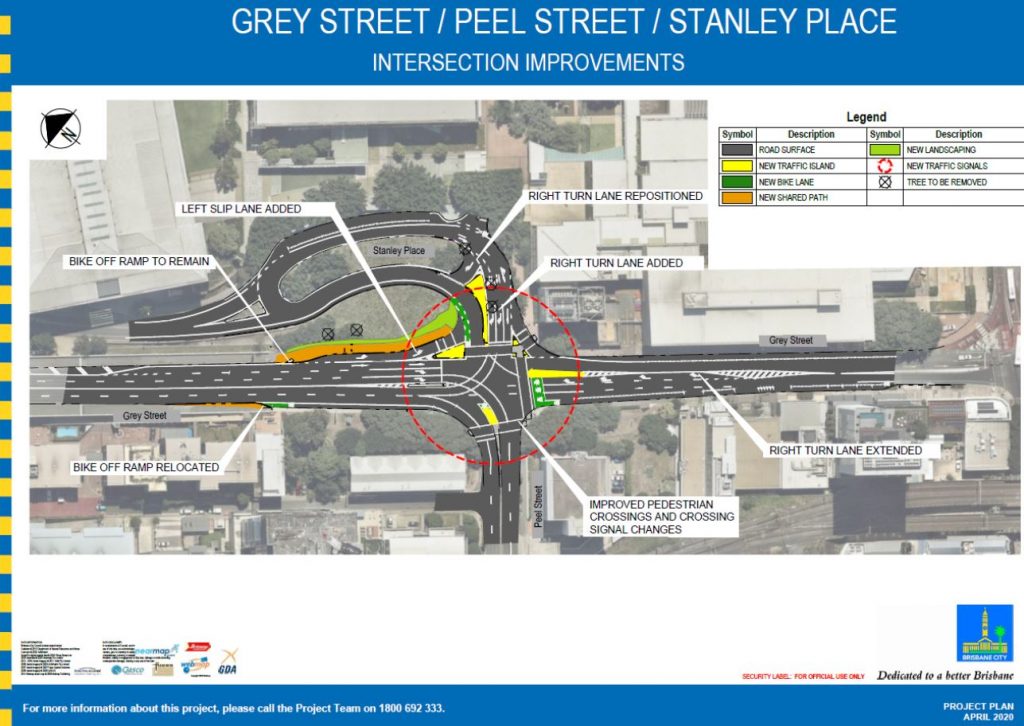
And even I, who knew they were bad in theory, was astonished to see what a total disaster the signalised slips here are in practice.
When I spoke to the lead engineer at Webster Road, one thing he assured me was that, because they’re not connected to the intersection cycle, signalised slip lanes are “pedestrian priority” and will immediately give pedestrians a green walk light when they press the button. I had my doubts about this, of course; there’s obviously always the delay of 5+ seconds while the lights change, and I was sure an additional timer would be added if the lights had been activated recently.
So I was keen to try this out in South Brisbane, and was expecting that, if I pressed the button a second time immediately after the lights had changed, I would have to wait 20 or 30 seconds for another walk signal.
So imagine my surprise to discover that the slip lane lights at South Brisbane are synchronised to the intersection! The slip off Grey St will only give pedestrians a walk signal at the same moment the Stanley Place traffic lights go green, and the slip off Stanley Place will only give a walk signal with the traffic on Grey St.
This means crossing this intersection legally would take pedestrians several cycles of the lights to get the three walk signals in sequence, and the maximum wait time I measured for the Grey St slip lane was – wait for it – 95 seconds.
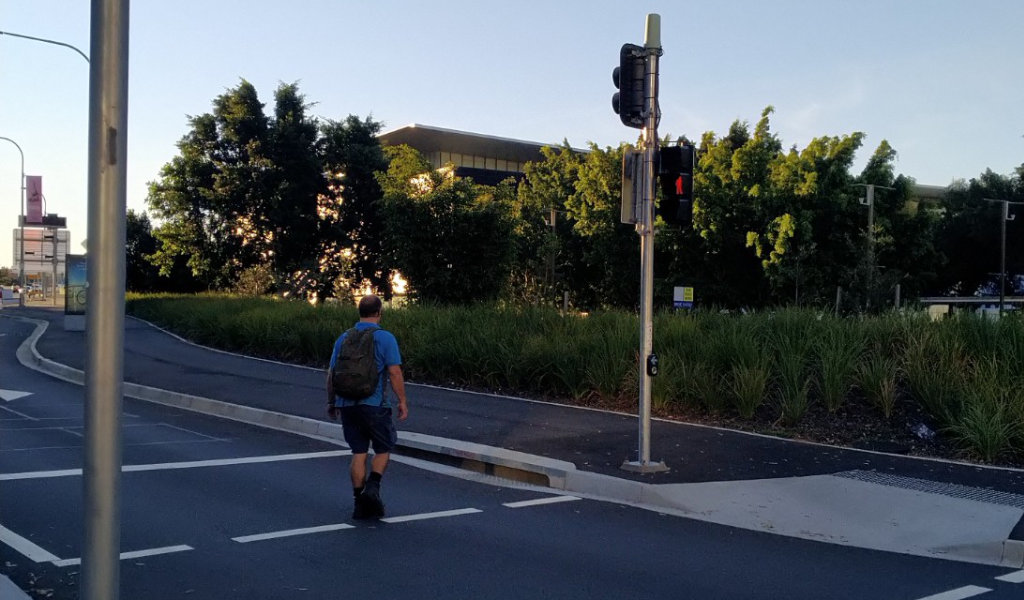
I was at South Brisbane observing the intersection and taking photos for about half an hour. In that time I saw:
- About a hundred pedestrians cross the slip lanes, with practically 0% compliance with the signals. A few pedestrians pressed the button, waited for a few seconds, then gave up and crossed anyway. Most pedestrians just ignored the signals completely.
- Several drivers get halfway down the slip lane, then slam on the brakes, look confused, and very cautiously creep around the corner. Because what does a blank signal head mean? Who knows…
- At least two drivers RUN THE RED LIGHT at the pedestrian crossings: one who stopped to let a pedestrian cross, then drove on before the signal cleared, and one who just sailed through the red arrow without stopping at all. Because expecting drivers to watch three things at once – pedestrians crossing, a signal light, and conflicting cross-traffic – doesn’t work and isn’t safe.
So if anyone’s still in any doubt that signalised slip lanes are a terrible, horrifically dangerous idea, head down to South Brisbane some time and watch them in action. Just try not to get run over while you’re there…
– D